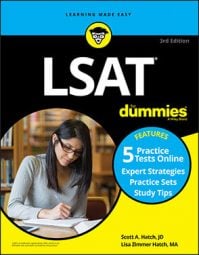LSAT questions that ask you to evaluate arguments often feature cause-and-effect reasoning. If the argument uses cause and effect to make its point, focus on the causes. Almost always, the right answer to a question that asks you to strengthen the argument shows that the cause mentioned is the most likely source of the effect.
The best answer for a question for which you have to weaken the argument points to another probable cause of the effect. Here’s how you apply this reasoning to a sample question:
Average hours of television viewing per American have sharply increased for more than three decades. Over the same period of time, there has been an increase in obesity rates in America. To fight the rise in obesity, Americans must limit their hours of television viewing.
Which one of the following, if true, would most weaken the author’s argument?
(A)A person burns more calories while watching television than while sleeping.
(B)Over the last 30 years, there has been an increase in the number of fast food restaurants in the United States.
(C)Americans spend most of their television time watching sports events rather than cooking shows.
(D)Television viewing in Japan has also increased over the past three decades.
(E)Studies show that the number of television commercials that promote junk food has risen over the past ten years.
To tackle this question, first identify the conclusion and the premises the author states or implies to reach that conclusion. The conclusion is pretty easy to spot. The last thought of the argument is that Americans must limit their hours of TV viewing to curb the rise in obesity. The author makes this judgment using the following evidence:
The author directly states that the number of TV viewing hours has increased over the last 30 years.
According to the author, the number of obese Americans has also increased.
The author implies that TV viewing causes obesity.
To weaken the argument that Americans have to reduce their TV watching, you have to find the answer choice that shows that there could be another cause for the rise in obesity.
You may have been tempted to select Choice (A) because it shows that TV watching may be less fat-producing than another activity, sleeping. But it doesn’t give you another reason for the rise in obesity. Choice (A) could be right only if it showed that Americans are sleeping more than they were 30 years ago. It doesn’t, so move on.
On the other hand, stating that during the same time period the number of fast food restaurants also increased introduces another possible cause of obesity and weakens the conclusion that Americans have to stop watching so much TV to get slimmer. Maybe it’s the popularity of fast food that’s the culprit! Choice (B) is a better answer than Choice (A), but read through all the possibilities before you commit.
Choice (C) is wrong because the argument contains nothing that suggests that the type of TV Americans watch affects their obesity, nor does Choice (C) show that viewing patterns have changed over the last three decades. You can eliminate Choice (C) from contention. And Choice (D) is also out because it doesn’t correlate what’s happening in Japan with what’s happening in the United States.
You don’t know whether Japanese citizens weigh more now than they did 30 years ago, so the information in Choice (D) is useless.
If the question had asked you to strengthen the conclusion, Choice (E) would be a good option. It shows a reason that increased TV watching could cause obesity. But the question asks you to weaken the conclusion, so Choice (B) is the best answer. It’s the only one that shows that there could be another cause for the rise in obesity.

